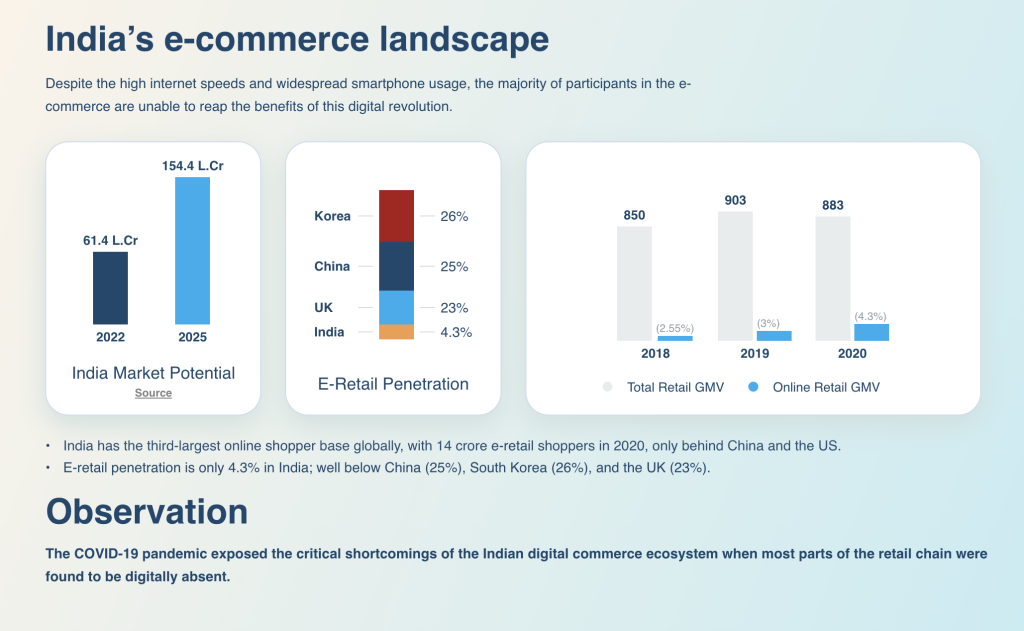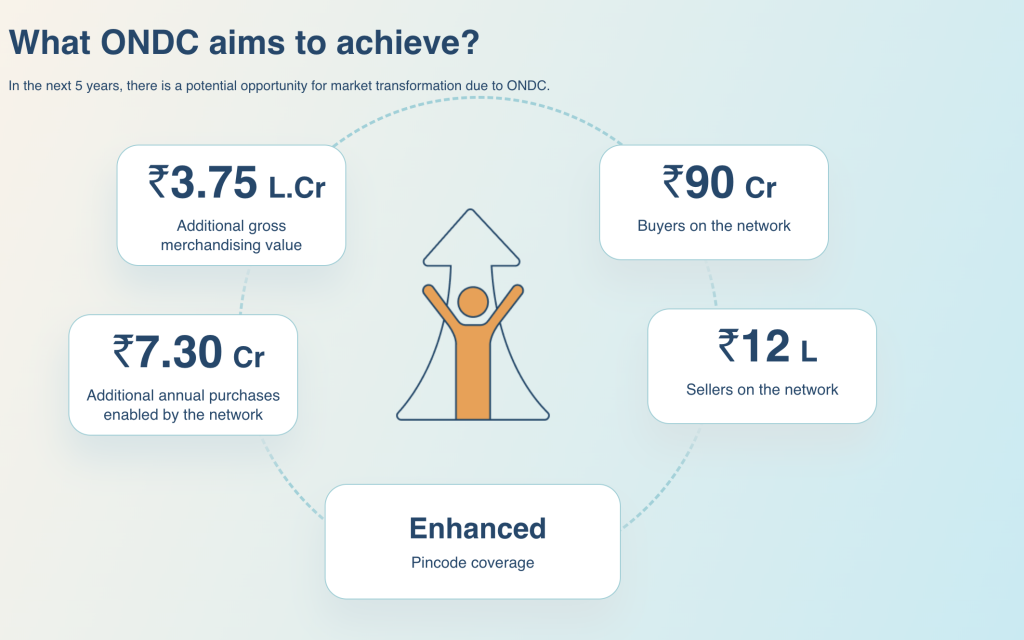India is one of the fastest-growing economies in the world, and digital commerce has emerged as a key driver of this growth. However, the digital commerce ecosystem in India is still fragmented, with multiple payment systems, logistics providers, and merchants operating in silos. This fragmentation not only creates friction in digital commerce but also limits the potential of small and medium-sized businesses to participate in the digital economy.
To address this challenge, the Indian government has launched the Open Network for Digital Commerce, or ONDC. This initiative aims to establish a shared digital infrastructure that will enable seamless integration between different merchants, payment systems, and logistics providers. The project is a collaboration between the National Payments Corporation of India (NPCI) and the Ministry of Commerce and Industry, with the goal of enabling seamless digital transactions and commerce across all sectors of the economy.

Benefits of Open Network for Digital Commerce (ONDC)
- Reduced costs: ONDC will help to reduce costs for both buyers and sellers. Buyers will be able to find better prices from a wider range of sellers. Sellers will be able to reach a larger audience and sell their products more easily.
- Improved efficiency: ONDC will help to improve efficiency for both buyers and sellers. Buyers will be able to find the products they need quickly and easily. Sellers will be able to manage their inventory and orders more efficiently.
- Greater choice: ONDC will give consumers more choice. Buyers will be able to find a wider range of products from a wider range of sellers. This will help to create a more competitive market and drive down prices.
- Boosted economy: ONDC has the potential to boost the Indian economy by creating new jobs and opportunities. The platform could help to level the playing field for small businesses and give them a better chance of success. This could lead to increased investment and job creation.
One of the key benefits of Open Network for Digital Commerce (ONDC) is the creation of a unified digital platform that will allow seamless integration between different merchants, payment systems, and logistics providers. This will help reduce the friction in digital commerce, making it easier for businesses of all sizes to participate in the digital economy. ONDC will also help drive financial inclusion by providing access to digital payments and commerce services to millions of unbanked and underbanked individuals across the country.
Another key benefit of ONDC is the increased transparency and accountability it brings to the digital commerce ecosystem. By establishing a shared digital infrastructure and standardizing data formats, ONDC will help reduce the risk of fraud and improve consumer trust in digital commerce. This will also help create a level playing field for small businesses that may have previously been disadvantaged by the dominance of larger players in the digital commerce space.
Moreover, the Open Network for Digital Commerce (ONDC) initiative is expected to boost overall economic growth in India. By reducing the friction in digital commerce and making it easier for businesses of all sizes to participate, ONDC is likely to increase competition, drive innovation, and create new business opportunities. This, in turn, is expected to generate employment and contribute to the growth of the Indian economy.
Open Network for Digital Commerce (ONDC): Challenges and Opportunities
- Competition: ONDC will face competition from existing e-commerce platforms, such as Amazon and Flipkart. These platforms have a large user base and a significant amount of investment. ONDC will need to find ways to differentiate itself from these platforms in order to attract users.
- Regulation: ONDC will need to comply with a number of regulations, both at the national and state level. These regulations could make it difficult to launch and operate the platform.
- Technology: ONDC will need to use cutting-edge technology in order to be successful. This technology could be expensive and difficult to implement.
While Open Network for Digital Commerce (ONDC) has the potential to revolutionize the digital commerce ecosystem in India, there are also several challenges that need to be overcome. One of the biggest challenges is ensuring interoperability between the various systems and technologies used by different players in the ecosystem. This will require close collaboration between government bodies, industry associations, and private sector players.
Another challenge is ensuring the security and privacy of data exchanged on the Open Network for Digital Commerce (ONDC) platform. Given the sensitive nature of financial and personal information involved in digital commerce, it is critical that robust security and privacy measures are in place to protect against data breaches and cyber attacks.
Despite these challenges, ONDC presents a significant opportunity for businesses of all sizes to participate in the digital economy and tap into the vast market potential of India’s 1.3 billion consumers. By leveraging the shared digital infrastructure provided by ONDC, businesses can reduce their transaction costs, improve their operational efficiency, and reach new customers beyond their traditional geographic boundaries.

The Open Network for Digital Commerce (ONDC) initiative is also expected to have a significant impact on financial inclusion in India. By providing access to digital payments and commerce services to millions of unbanked and underbanked individuals across the country, ONDC has the potential to bring these individuals into the formal financial system. This, in turn, is expected to boost overall economic growth by increasing the velocity of money and promoting entrepreneurship.
What can Nepal learn from this initiative?
The Open Network for Digital Commerce (ONDC) initiative in India presents a model for other countries, including Nepal, to consider in their efforts to promote digital commerce and financial inclusion. Nepal, like India, has a fragmented digital commerce ecosystem that could benefit from the creation of a shared digital infrastructure. By establishing a platform that enables seamless integration between different merchants, payment systems, and logistics providers, Nepal could reduce the friction in digital commerce and make it easier for businesses of all sizes to participate in the digital economy. This, in turn, could boost overall economic growth and promote entrepreneurship. However, as with any such initiative, there are challenges that need to be addressed, such as ensuring interoperability, complying with regulations, and protecting against data breaches and cyber attacks. By learning from India’s experience with ONDC and addressing these challenges, Nepal could create a more vibrant digital commerce ecosystem that benefits all stakeholders.
Also Read: Nepal’s Economy Shows Strength Amid Global Crisis: NRB Report
Conclusion
In conclusion, the Open Network for Digital Commerce is a game-changing initiative that has the potential to transform the way commerce is conducted in India. By establishing a shared digital infrastructure and standardizing data formats, ONDC will help reduce the friction in digital commerce and drive financial inclusion across the country. While there are certainly challenges to be overcome, the opportunities presented by ONDC are too significant to ignore. As the project continues to evolve and grow, it will be exciting to see how it shapes the future of digital commerce in India and beyond.


